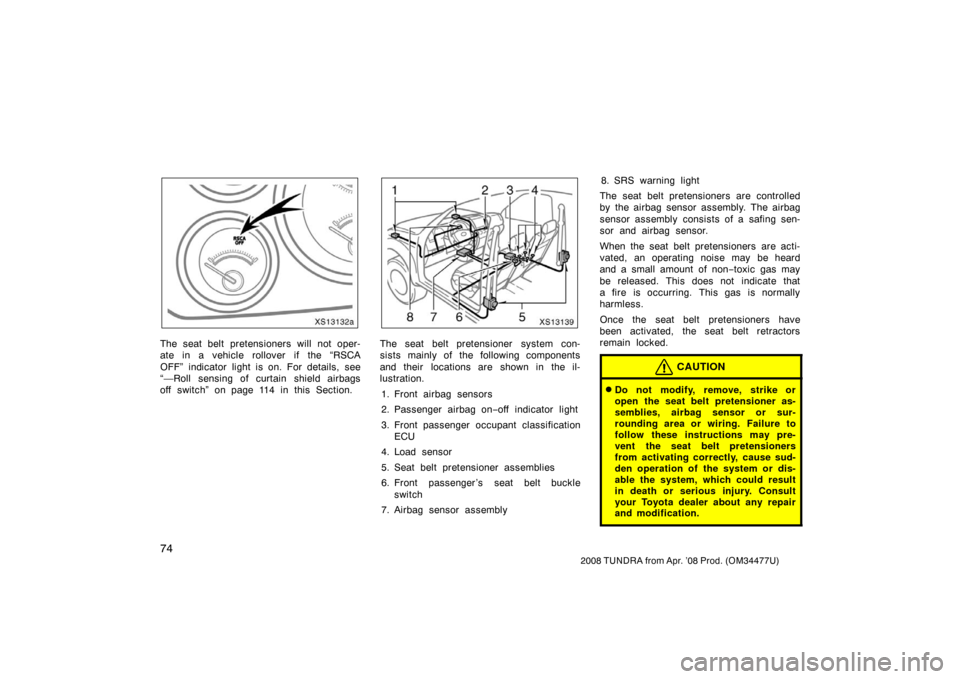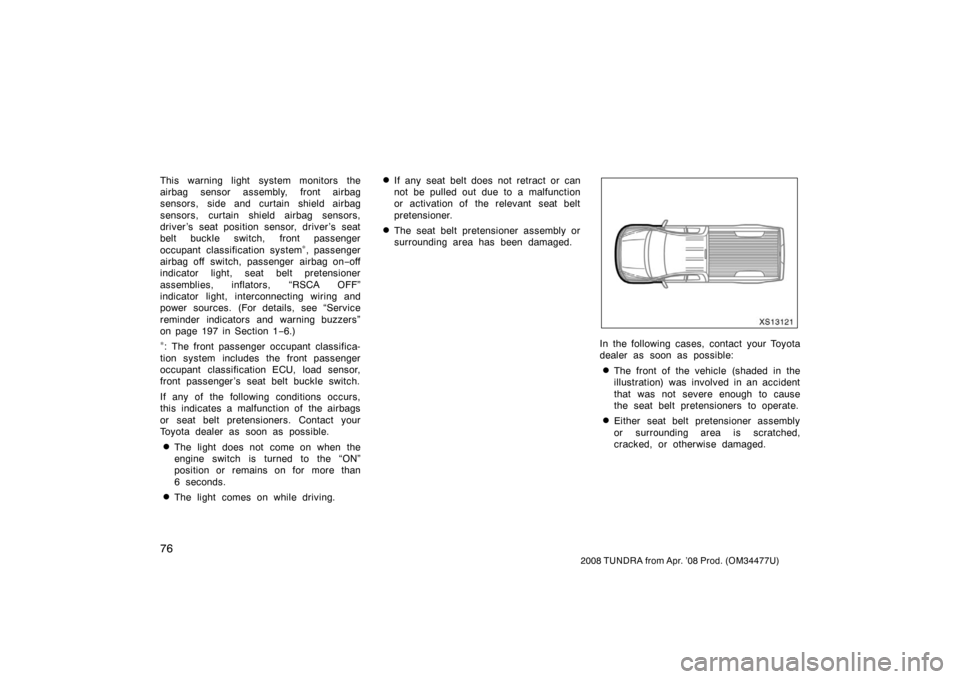Page 16 of 621
6
2008 TUNDRA from Apr. ’08 Prod. (OM 34477U)
17. Power back window switch
(Crew Max models)
18. Tire pressure warning reset switch
19. “VSC OFF” switch
20. Power outlet main switch (with rear seat entertainment system)
21. Cruise control switch
22. Engine switch
23. Accessory meter
24. Engine immobilizer/theft deterrent system indicator light
25. Intuitive parking assist indicator lights
Page 18 of 621
8
2008 TUNDRA from Apr. ’08 Prod. (OM 34477U)
17. Power back window switch
(Crew Max models)
18. Tire pressure warning reset switch
19. “VSC OFF” switch
20. Power outlet main switch (with rear seat entertainment system)
21. Cruise control switch
22. Engine switch
23. Accessory meter
24. Engine immobilizer/theft deterrent system indicator light
25. Intuitive parking assist indicator lights
Page 20 of 621
10
2008 TUNDRA from Apr. ’08 Prod. (OM 34477U)
17. Power back window switch
(Crew Max models)
18. Tire pressure warning reset switch
19. “VSC OFF” switch
20. Power outlet main switch (with rear seat entertainment system)
21. Cruise control switch
22. Engine switch
23. Accessory meter
24. Engine immobilizer/theft deterrent sys- tem indicator light
25. Intuitive parking assist indicator lights
XS10010a
1. Audio remote control switches
2. Telephone switches
3. Talk switch
XS11007a
Ty p e A
XS11024
Ty p e B
Steering switches and
overhead console overview
� Steering switches �
Overhead console
Page 25 of 621
15
2008 TUNDRA from Apr. ’08 Prod. (OM 34477U)
Driver ’s seat belt reminder light∗
1
Low engine oil pressure warning light∗1
Brake system warning light∗1
Charging system warning light∗1
Malfunction indicator lamp∗1
Anti −lock brake system warning light∗
1
SRS warning light∗1
or
Front passenger ’s seat belt reminder light∗1
Passenger airbag on −off indicator light
Engine oil replacement reminder light∗
1
(for vehicles sold in U.S.A.)
Open door warning light∗ 1
Tire pressure warning light∗1
Automatic transmission fluid temperature
warning light∗1
Engine immobilizer/theft deterrent system
indicator lightLow fuel level warning light∗1
Master warning light∗1
Low windshield washer fluid level warning light∗1
or
Indicator symbols on the instrument panel
Page 26 of 621
16
2008 TUNDRA from Apr. ’08 Prod. (OM 34477U)
∗
1: For details, see “Service reminder indicators and warning
buzzers” on page 197 in Section 1 −6.
∗
2: If this light flashes, see “Cruise control” on page 262 in
Section 1 −7.
∗
3: If this light flashes, see “Four −wheel drive system” on page
240 in Section 1 −7.
∗
4: For details, see “—Roll sensing of curtain shield airbags off
switch” on page 114 in Section 1 −3.
Cruise control indicator light
∗
2
Slip indicator light∗1
Vehicle stability control system off indicator
light∗ 1
“AUTO LSD” indicator light
Headlight high beam indicator light
Turn signal indicator lights
Tail light indicator light
Low speed four −wheel drive indicator light∗
3
(four −wheel drive models) Tow/haul mode indicator light
Headlight low beam indicator light
High speed four
−wheel drive indicator light∗
3
(four −wheel drive models)
Roll sensing of curtain shield airbags off
indicator light∗
4
Page 84 of 621

74
2008 TUNDRA from Apr. ’08 Prod. (OM 34477U)
XS13132a
The seat belt pretensioners will not oper-
ate in a vehicle rollover if the “RSCA
OFF” indicator light is on. For details, see
“—Roll sensing of curtain shield airbags
off switch” on page 114 in this Section.
XS13139
The seat belt pretensioner system con-
sists mainly of the following components
and their locations are shown in the il-
lustration.
1. Front airbag sensors
2. Passenger airbag on −off indicator light
3. Front passenger occupant classification ECU
4. Load sensor
5. Seat belt pretensioner assemblies
6. Front passenger ’s seat belt buckle switch
7. Airbag sensor assembly 8. SRS warning light
The seat belt pretensioners are controlled
by the airbag sensor assembly. The airbag
sensor assembly consists of a safing sen-
sor and airbag sensor.
When the seat belt pretensioners are acti-
vated, an operating noise may be heard
and a small amount of non −toxic gas may
be released. This does not indicate that
a fire is occurring. This gas is normally
harmless.
Once the seat belt pretensioners have
been activated, the seat belt retractors
remain locked.
CAUTION
�Do not modify, remove, strike or
open the seat belt pretensioner as-
semblies, airbag sensor or sur-
rounding area or wiring. Failure to
follow these instructions may pre-
vent the seat belt pretensioners
from activating correctly, cause sud-
den operation of the system or dis-
able the system, which could result
in death or serious injury. Consult
your Toyota dealer about any repair
and modification.
Page 86 of 621

76
2008 TUNDRA from Apr. ’08 Prod. (OM 34477U)
This warning light system monitors the
airbag sensor assembly, front airbag
sensors, side and curtain shield airbag
sensors, curtain shield airbag sensors,
driver ’s seat position sensor, driver ’s seat
belt buckle switch, front passenger
occupant classification system
∗, passenger
airbag off switch, passenger airbag on −off
indicator light, seat belt pretensioner
assemblies, inflators, “RSCA OFF”
indicator light, interconnecting wiring and
power sources. (For details, see “Service
reminder indicators and warning buzzers”
on page 197 in Section 1 −6.)
∗: The front passenger occupant classifica-
tion system includes the front passenger
occupant classification ECU, load sensor,
front passenger ’s seat belt buckle switch.
If any of the following conditions occurs,
this indicates a malfunction of the airbags
or seat belt pretensioners. Contact your
Toyota dealer as soon as possible.
�The light does not come on when the
engine switch is turned to the “ON”
position or remains on for more than
6 seconds.
�The light comes on while driving.
�If any seat belt does not retract or can
not be pulled out due to a malfunction
or activation of the relevant seat belt
pretensioner.
�The seat belt pretensioner assembly or
surrounding area has been damaged.
XS13121
In the following cases, contact your Toyota
dealer as soon as possible:
�The front of the vehicle (shaded in the
illustration) was involved in an accident
that was not severe enough to cause
the seat belt pretensioners to operate.
�Either seat belt pretensioner assembly
or surrounding area is scratched,
cracked, or otherwise damaged.
Page 91 of 621

81
2008 TUNDRA from Apr. ’08 Prod. (OM 34477U)
9. Driver ’s seat position sensor
10. Airbag sensor assembly
11. Airbag module for driver (airbag and inflator)
12. SRS warning light
The airbag sensor assembly consists of a
safing sensor and airbag sensor.
The airbag sensors constantly monitor the
forward deceleration of the vehicle. If an
impact results in a forward deceleration
beyond the designed threshold level, the
system triggers the airbag inflators. At this
time a chemical reaction in the inflators
very quickly fills the air bags with non−tox-
ic gas to help restrain the forward motion
of the occupants. The front airbags then
quickly deflate, so that there is no ob-
struction of the driver ’s vision should it be
necessary to continue driving. When the airbags inflate, they produce a
loud noise and release some smoke and
residue along with non
−toxic gas. This
does not indicate a fire. This smoke may
remain inside the vehicle for some time,
and may cause some minor irritation to
the eyes, skin or breathing. Be sure to
wash off any residue as soon as possible
to prevent any potential skin irritation with
soap and water. If you can safely exit
from the vehicle, you should do so imme-
diately. Deployment of the airbags happens in a
fraction of a second, so the airbags must
inflate with considerable force. While the
system is desi
gned to reduce serious inju-
ries, primarily to the head and chest, it
may also cause other, less severe injuries
to the face, chest, arms and hands. These
are usually in the nature of minor burns
or abrasions and swelling, but the force of
a deploying airbag can cause more seri-
ous injuries, especially if an occupant’s
hands, arms, chest or head is in close
proximity to the airbag module at the time
of deployment. This is why it is important
for the occupant to: avoid placing any
object or part of the body between the
occupant and the airbag module; sit
straight and well back into the seat; wear
the available seat belt properly; and sit as
far as possible from the airbag module,
while still maintaining control of the ve-
hicle.
Parts of the airbag module (steering wheel
hub, airbag cover and inflator) may be hot
for several minutes after deployment, so
do not touch! The airbags inflate only
once. The windshield may be damaged by
absorbing some of the force of the inflat-
ing airbag.